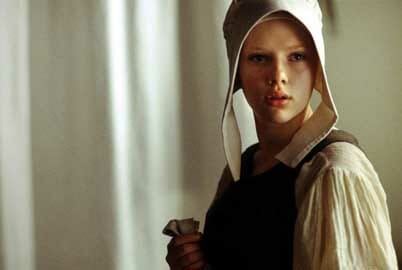Girl With A Pearl Earring

There’s something to be said for a film that’s most sensual moments involve the piercing of an ear and the removal of a bonnet—just a bonnet—from the head of a woman who always dresses in layers. But as Girl With A Pearl Earring demonstrates, it’s hard to make a convincing film about an artist. It’s not easy to understand, much less depict, why and how an artist creates, and translating the creation itself to a very different medium is tricky at best.
It’s easier to avoid all the complications and instead seize on a concrete element of the artist’s life for a simple, irrelevant story—about his love life or, say, his love life—illuminating nothing, but basking in the glow of Art with a capital A. The film goes one step further by telling the entirely fictional story of how Johannes Vermeer might have painted his most famous work. At the end of Martin Scorsese’s Bringing Out the Dead, a pietà unexpectedly takes form and sheds new light on the movie’s themes, but Girl With A Pearl Earring attempts to do the opposite, to shed new light on the painting that takes form at its conclusion. It seems like a fun project but also a pointless one, especially if the story only intends to skim the surface of its subject. In one scene, a character is talking about one of Vermeer’s paintings, but he is shot such that his shoulder obscures the topic of his speech, and there you have the movie’s priorities in a nutshell.
Based on a novel, Girl With A Pearl Earring is the first feature by Peter Webber, and even if it doesn’t attempt to understand Vermeer, it does show a mastery of its own visual art. Every frame looks stunning, as if Webber and his crew surrounded themselves with Vermeer’s paintings and adopted his palette for the glowing yellow faces of the people dressed for tea and the deep blue suits of the men on the sidewalk, both of which subtly echo the dialog. The imitation ends with the film’s use of the frame, which is purely cinematic. Scarlett Johansson plays Griet, a servant girl in Vermeer’s household and eventually the subject of the painting that shares the movie’s title. At one point, Griet is quietly setting the dinner table. The frame around her expands to include Vermeer, played by Colin Firth, who is watching her work. Then it expands again to show Vermeer’s mother-in-law watching Vermeer watching Griet, with his wife situated in the middle. His wife asks for help with her necklace to refocus his attention, and failing that, she snaps at Griet, asking her if she’s quite finished setting the table. This scene may not say much about Vermeer as an artist and it may not be very subtle, but it’s a visually graceful summary of the movie’s dramatic triangle.
Although she plays the film’s title figure, Johansson is often slinking around in the background. When Vermeer takes Griet’s hands to teach her how to grind the ingredients for paint, she draws them back abruptly. He’s gone too far. The movie benefits greatly from Johansson’s gift for understated delivery, but she’s less assured in this demure, largely non-verbal role than she was as a modern young woman in Ghost World and Lost in Translation. Some of the fault probably belongs to Webber or his editor for cutting so haphazardly among Johansson’s three main facial expressions—open-mouthed awe, eye-darting nervousness, and furrow-browed curiousness. As Griet is forming an opinion of her new employer, the shots jump from one expression to another, making it difficult for us to get a handle on her thoughts.
As a drama about unrequited romance, the film works well enough. The most tensely sensual scenes are the ones with the least potential for sex, and although Griet has the eye of every man in the story, the movie refuses to entertain a torrid affair between Vermeer and Griet, preferring instead to leave her as an enigma. This is commendable in a sense but also somewhat contradictory: the movie is trying to explain away the mystery of Vermeer’s painting, but it still hopes to claim some of that mystery for its invented characters.
GET PASTE RIGHT IN YOUR INBOX
The best music, movies, TV, books, comedy and more.